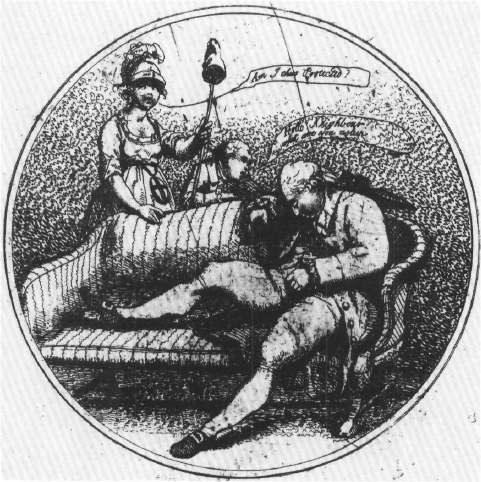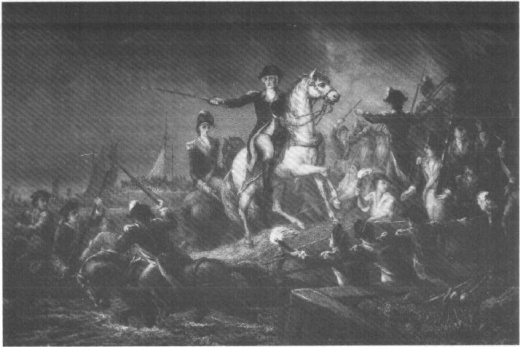Conceived in Liberty (235 page)
Read Conceived in Liberty Online
Authors: Murray N. Rothbard

Courtesy of the New-York Historical Society, New York City.
Horatio Gates

Courtesy of the New-York Historical Sociery, New York City.
1781 Caricature: The State Watchman Discovered by the Genius Britain Studying Plans for the Reduction of America

Courtesy of the New-York Historical Society, New York City.
Washington’s Retreat at Long Island, August 1776
New Jersey and Maryland Follow
New Jersey, a scene of conflict between Rebel and Tory, had felt understandably diffident about antagonizing its two powerful and archconservative neighbors, New York and Pennsylvania. Lexington and Concord galvanized New Jersey as it did the other colonies, and a provincial convention in Trenton was formed in the spring of 1775 out of a general provincial conference of county committeemen. But while favoring military measures, the convention had continued to protest its loyalty to the king. By early 1776, the New Jersey revolutionaries had established a provincial congress, with a committee of safety as its executive arm. Even so, the Tories remained strong in New Jersey, and Royal Gov. William Franklin continued to be active in political affairs, as we have seen. Leading the radically militant forces in New Jersey was the distinguished president of Princeton College, the Scottish-born Rev. Dr. John Witherspoon. An early advocate of independence, he had seen his students fill the ranks of the Sons of Liberty, and he was prominent enough in the Revolution that he was one of the three Americans burned in effigy by the British and Tories when General Howe captured Staten Island in July 1776.
By early June, an internal drive for militancy, combined with the transformation of Pennsylvania, easily swung New Jersey into the independence camp. The elections to the June meeting of the provincial congress at Burlington produced a clear radical victory; two conservative delegates to Philadelphia were immediately recalled, and on June 21 the New Jersey congress selected an entirely new delegation, all of whom staunchly favored independence. The new delegation included Witherspoon. The
provincial congress also ordered the arrest of Governor Franklin, sent him to prison in Connecticut, and authorized the delegates to Philadelphia to concur in a declaration of independence.
After completing this drive for independence, the provincial congress promptly decided to write a constitution for the virtually independent province. The new constitution, on which Dr. Witherspoon was the main influence, was approved at the beginning of July. It was moderately conservative, establishing a bicameral legislature; but also, by a vote of five counties to four, abolishing the old freehold qualifications for voting. Suffrage was broadened to all inhabitants with assets, personal or real, valued at fifty or more pounds. Perhaps through careless wording, the unintended effect of the legislation, after a time, was to give the vote to widows inheriting property worth at least fifty pounds—an initial breakthrough for women’s suffrage.
New Jersey’s swift adhesion to the cause of independence left only Maryland and New York unconverted. Maryland was a proprietary colony of the Baltimore family, and for a century its politics had been expressed in terms of pro- and antiproprietary parties. The “Court Party” was the party of the allies and receivers of special privilege from the proprietary. It defended the quitrents and other exactions imposed by the Baltimores. It naturally controlled appointed officialdom, the governor, the council, the established Anglican clergy, and the body of the petty bureaucracy. In opposition was the “Country Party,” dominating the elected lower house of the legislature. Added to the disfranchisement of the sizeable minority of Roman Catholic voters, the property qualifications for voting proved high enough to disfranchise proportionately more citizens in Maryland than in any other province; probably little more than two-fifths of the white adult males of Maryland were eligible to vote. Furthermore, as elsewhere in the south, apportionment for the assembly was weighted heavily in favor of the older eastern counties, containing large slave-holding plantations and fewer white citizens than the western counties. Every county, regardless of population, had equal representation in the assembly.
The exactions of the proprietary upon the land of the inhabitants were not merely academic; they included quitrents, caution money from land purchasers, rents from proprietary manors, and alienation fines on those who transferred their land. From these sources as well as fines and fees and tonnage and export duties on Maryland’s staple, tobacco, the proprietary derived a net annual income in the decade before the Revolution of 12,500 pounds. In addition to this substantial sum, the people of Maryland were forced to pay 12,000 pounds in taxes per year to support the proprietary officials who enforced these exactions upon them, as well as 8,000
pounds to support the established Anglican clergy. Thus, over 32,000 pounds were extracted from the Marylanders to support the proprietary and a hundred-odd appointed bureaucrats and ministers; in contrast, the entire government of Maryland, including provincial, county, and local operations, cost Maryland only 18,500 pounds per year. It is easy to see that saddled with perhaps the most expensive state in the colonies, the grievances of the Country Party were real indeed. Both court and country parties were dominated by the social and economic leaders of the province, the wealthy planter oligarchs, their wealth based on slave cultivation of tobacco.
The continuing attack by the Country Party on the place and privileges of the Court Party led naturally to their leading the wider opposition to British exactions in Maryland. In the course of the revolutionary movement, the Country Party established periodic extralegal provincial conventions, with a council of safety appointed to operate in the interior. The provincial convention functioned as a supreme court and appointed county committees.
No American colony labored under such tight control of a small interlocking clique as Maryland under the Country Party. Virtually complete control was exercised by a very few men. First and foremost was the very wealthy Matthew Tilghman, head of a very prominent and powerful planter family on Maryland’s Eastern Shore. Tilghman presided over all the provincial conventions, was usually president of the Council of Safety, and, later, was president of Maryland’s constitutional convention. Also prominent was Edward Lloyd, first cousin of Tilghman and an extremely wealthy member of another leading Eastern Shore family. Lloyd was one of the largest slaveowners in Maryland and one of the biggest wheat growers in all the colonies.
Another important figure in the province was Charles Carroll of Carroll-ton. A resident of the capital city of Annapolis, Carroll had the largest slaveholdings in Maryland and was not only the wealthiest man in the province, but one of the wealthiest in America. A delegate to the Continental Congress, he achieved political prominence despite being a Roman Catholic. Almost equally important was another Charles Carroll of Annapolis, a distant relation to Carroll of Carrollton. Yet another Charles Carroll was the son-in-law of Carroll of Carrollton; he, too, was one of the wealthiest people in Maryland.
Three prominent Annapolis lawyers, once partners, rounded out the Country Party leadership. William Paca, a delegate to the Continental Congress, made his fortune by marrying into the Lloyd family and became a leading planter and slaveowner. Thomas Johnson, another congressional delegate, specialized in acquiring land grants in unoccupied western Maryland. (Before the Revolution, having put on enough pressure to gain
himself the land, Johnson had joined with George Washington to try to persuade the Maryland and Virginia legislatures to open a vast Potomac navigation system to raise the value of their lands enormously.) The third of these lawyers, Samuel Chase, was also a delegate to the Continental Congress.
Under this sort of control, it is not surprising that Maryland’s revolutionary movement was staunchly conservative and opposed the radical drive for independence, and as we have seen, Robert Eden was courteously allowed to remain as nominal governor, though he retained no power. As late as May 15, 1776, the Maryland Provincial Convention reconfirmed its aim of reconciliation with Britain and its corrollary instructions to the delegates at Philadelphia. The American radicals almost despaired of Maryland, but its very tight control afforded a chance of radical change through conversion of a few of the inner circle. The break came with the ardent adoption of the independence cause by two of the top oligarchs, Samuel Chase and Charles Carroll of Carrollton. To gain sufficient support and pressure for independence, they were forced to stump the western country, raising demands for independence among the Maryland masses, thus taking the risk of arousing domestic radicalism as well. In fact, along with a host of local committee resolutions for independence in western Maryland, many of the local groups were stimulated to agitate for domestic reform. Committees in western Frederick County, seeing the link between independence and domestic change, attacked the “tyranny” and discrimanatory representation in the Assembly as part of an effort to develop political organs that would agree to independence. Military participation heightened pressure for reform, as soldiers in the fight against Britain felt with a special keenness their disfranchisement and handicaps in representation. They pressed for broadening the highly restrictive Maryland suffrage, and demands arose for allowing all adult arms-bearing taxpayers the right to vote. Clearly, mass democratic pressure was beginning to push against the tight aristocratic control of the province.
Chase’s campaign and western mass pressure effected a remarkable change in Maryland’s position, a shift aided by Maryland’s sudden unwelcome isolation among the colonies and General Lee’s agitation from Williamsburg. Moreover, Maryland was sternly confronted by the request of the Continental Congress for military aid, and this presented the stark choice of conforming or standing alone. Finally, on June 28, the Maryland convention revoked its instructions against independence and authorized its delegates to join in a declaration of independence. Governor Eden was gracefully permitted to leave for Britain on a British warship. The convention also decided to draft a state constitution on August 1. Property qualifications for the constitutional convention were to remain the same, but representation was partially corrected by splitting Frederick County
into three parts and adding more delegates from the major cities of Baltimore and Annapolis.
Thus, by the end of June, all the colonies but one stood foursquare for independence, and almost all had either formally adopted a new government or were in the process of doing so. But one—New York—powerful and firmly in archconservative hands, still stood in the way of American independence.
Independence Declared
On June 7, in happy obedience to the instructions resolved by Virginia on May 15, Richard Henry Lee submitted to the Continental Congress a momentous resolution for the independence of the United Colonies. His resolution embodied three historic affirmations. First was a declaration of independence: “that these United Colonies are, and of right ought to be, free and independent States, that they are absolved from all allegiance to the British Crown, and that all political connection between them and the State of Great Britain is, and ought to be, totally dissolved.” One of the great virtues as well as a corollary of independence would be the ability to form alliances with France and other countries in support of the war; so Lee’s second resolve affirmed the utility of forming such alliances. Finally, if the colonies were now to be separate and independent states, it was clear that no war, especially no war with a regular army, could be waged unless the states were in some way united; and it was believed that a formal compact of unity was needed to bolster the standing of the Continental Congress, just as formal government was supposedly needed by each state to replace spontaneous and anarchic rule by organized networks of local committees. Therefore, Lee’s third resolution instructed that a “plan of confederation” be drawn up and submitted to the separate states.
